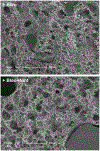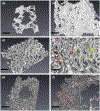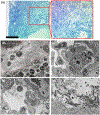Effects of nintedanib on the microvascular architecture in a lung fibrosis model
- PMID: 28283856
- PMCID: PMC7412751
- DOI: 10.1007/s10456-017-9543-z
Effects of nintedanib on the microvascular architecture in a lung fibrosis model
Abstract
Nintedanib, a tyrosine kinase inhibitor approved for the treatment of idiopathic pulmonary fibrosis, has anti-fibrotic, anti-inflammatory, and anti-angiogenic activity. We explored the impact of nintedanib on microvascular architecture in a pulmonary fibrosis model. Lung fibrosis was induced in C57Bl/6 mice by intratracheal bleomycin (0.5 mg/kg). Nintedanib was started after the onset of lung pathology (50 mg/kg twice daily, orally). Micro-computed tomography was performed via volumetric assessment. Static lung compliance and forced vital capacity were determined by invasive measurements. Mice were subjected to bronchoalveolar lavage and histologic analyses, or perfused with a casting resin. Microvascular corrosion casts were imaged by scanning electron microscopy and synchrotron radiation tomographic microscopy, and quantified morphometrically. Bleomycin administration resulted in a significant increase in higher-density areas in the lungs detected by micro-computed tomography, which was significantly attenuated by nintedanib. Nintedanib significantly reduced lung fibrosis and vascular proliferation, normalized the distorted microvascular architecture, and was associated with a trend toward improvement in lung function and inflammation. Nintedanib resulted in a prominent improvement in pulmonary microvascular architecture, which outperformed the effect of nintedanib on lung function and inflammation. These findings uncover a potential new mode of action of nintedanib that may contribute to its efficacy in idiopathic pulmonary fibrosis.
Keywords: Angiogenesis inhibitors; Idiopathic pulmonary fibrosis; Intussusceptive angiogenesis; Microvascular corrosion casting; Synchrotron radiation tomographic microscopy.
Figures








References
-
- Raghu G, Collard HR, Egan JJ, Martinez FJ, Behr J, Brown KK, Colby TV, Cordier JF, Flaherty KR, Lasky JA, Lynch DA, Ryu JH, Swigris JJ, Wells AU, Ancochea J, Bouros D, Carvalho C, Costabel U, Ebina M, Hansell DM, Johkoh T, Kim DS, King TE, Kondoh Y, Myers J, Muller NL, Nicholson AG, Richeldi L, Selman M, Dudden RF, Griss BS, Protzko SL, Schunemann HJ (2011) An official ATS/ERS/JRS/ALAT statement: idiopathic pulmonary fibrosis: evidence-based guidelines for diagnosis and management. Am J Respir Crit Care Med 183:788–824 - PMC - PubMed
-
- King TE Jr, Pardo A, Selman M (2011) Idiopathic pulmonary fibrosis. Lancet 378:1949–1961 - PubMed
-
- Bonner JC (2004) Regulation of PDGF and its receptors in fibrotic diseases. Cytokine Growth Factor Rev 15:255–273 - PubMed
-
- Inoue Y, King TE Jr, Barker E, Daniloff E, Newman LS (2002) Basic fibroblast growth factor and its receptors in idiopathic pulmonary fibrosis and lymphangioleiomyomatosis. Am J Respir Crit Care Med 166:765–773 - PubMed
-
- Khalil N, O’Connor RN, Unruh HW, Warren PW, Flanders KC, Kemp A, Bereznay OH, Greenberg AH (1991) Increased production and immunohistochemical localization of transforming growth factor-beta in idiopathic pulmonary fibrosis. Am J Respir Cell Mol Biol 5:155–162 - PubMed
MeSH terms
Substances
Grants and funding
LinkOut - more resources
Full Text Sources
Other Literature Sources

